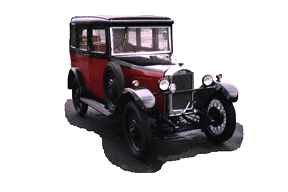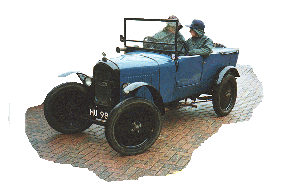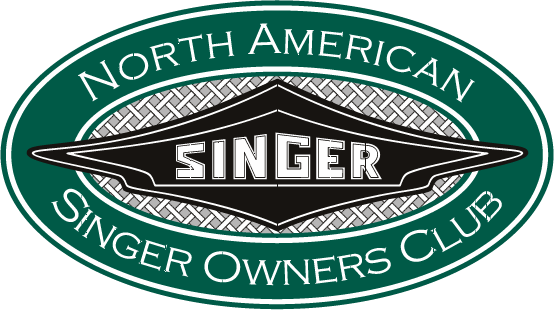Junior
In 1926, Singer introduced the 848cc Singer Junior at the London Car Show. In stark contrast to its later years, it was initially only available in one body style as a three door, four seater Tourer painted blue with black wings. It was powered by an 8 horsepower, two bearing, overhead camshaft engine which developed a peak of 16.5 horsepower at 3250 R.P.M. Although diminutive, this engine would be the progenitor of Singer power units for the next three decades.
The Junior came with a three speed gear box and initially was fitted with rear brakes only, with four wheel braking to be introduced in 1928. A four speed transmission, which would boost top end speed to 50 m.p.h., would only become available for the 1931 model year.  It was equipped with an inverted cone clutch, quarter-elliptic front springs, six volt electrics, gravity feed and disc wheels shod with 27 X 4 inch tires. Shock absorbers were not an option for 1926. A Tourer, weighing 1,288 pounds was capable of a speed of approximately forty-five m.p.h. and sold for 148 pounds ($740 at the exchange rate of the day).
It was equipped with an inverted cone clutch, quarter-elliptic front springs, six volt electrics, gravity feed and disc wheels shod with 27 X 4 inch tires. Shock absorbers were not an option for 1926. A Tourer, weighing 1,288 pounds was capable of a speed of approximately forty-five m.p.h. and sold for 148 pounds ($740 at the exchange rate of the day).
The Junior was a very popular car, with Singer selling many thousands of units in various forms, with production after 1927 never dropping below 6000 units per year. By 1928, it was the mainstay of Singer’s product line and was mainly responsible for the company’s status as the number three manufacturer of private cars in England in 1928.
While the first Junior was an open touring class car, it was soon offered in an array of other body styles, including a Two Seater Tourer, a Four Seater Tourer, a Sunshine Saloon, a Coachbuilt Saloon, a Fabric Saloon, a two plus two called the Sportsman’s Coupe and a boat-tailed, wire wheeled Porlock Sports. The latter, which was originally built as a special two seater Junior 8, set up a curious automotive record under the supervision of the Royal Automobile Club by climbing the 1:4 gradient Porlock Hill 100 times in 15 hours.Thereafter this model was known as the Porlock Sports and as such, would be the pointer for the Singer image of the thirties.
The latter, which was originally built as a special two seater Junior 8, set up a curious automotive record under the supervision of the Royal Automobile Club by climbing the 1:4 gradient Porlock Hill 100 times in 15 hours.Thereafter this model was known as the Porlock Sports and as such, would be the pointer for the Singer image of the thirties.
For 1931, Singer undertook a re-design of the Junior engine. While the block remained virtually unchanged with a bore of 56mm and a stroke of 86mm, the dynamo and distributor were moved to the offside of the engine and driven by a secondary chain. The oil sump was deepened to give an additional two and a half pints capacity and the oil suction pipe and filter were moved to the rear to remain submerged during hill climbs.
The redesigned engine, with an output now increased to 9 horsepower, coupled with a new 4 speed gearbox, was installed in the Junior Special Saloon introduced at the 1931 Olympia Motor Show. However, not satisfied to rest on their laurels, Singer then replaced the aging Junior four months later with a new 1932 model called the Singer “9”. The new Singer “9” was a sporty two seater which performed exceptionally well in local reliability trials and even competed in the international Monte Carlo Rally. Its modest successes in these competitions and the growing popularity of motorsport in Britain was enough to encourage Singer to develop a greatly improved sports model to be introduced in October 1932.
As an interesting footnote, there was an attempt by the dying Aga concern to build the Junior under license in Germany and a German Junior Tourer, priced at 3,325 marks, was actually exhibited at the 1928 Berlin Motor Show. However, it never went into production.
Junior Specs
Engine
Four cylinder, 56 mm. by 86 mm. = 848c.c.
Treasury rating, 7.78 h.p.
Special and Sports
Four cylinder, 60mm. by 86 mm = 972cc
RAC rated hp, 8.93
Gearbox and Transmission
Three speed
Inverted cone clutch
Wheels and Brakes
26 X 4 inch tires
Two wheel mechanical brakes,
General
Wheelbase 7 ft. 6 ins.
Track 3ft 8in
Tyre size 26 X 4
Tyre pressure 28 lbs. sq. in. front, 28 lbs. sq. in
Petrol tank capacity 6 1/2 gallons
Engine Oil capacity 6 1/2 pints
Gearbox capacity 2 pints
Real axle capacity 3 pints
Water capacity 2 gallons
Price
148 pounds
